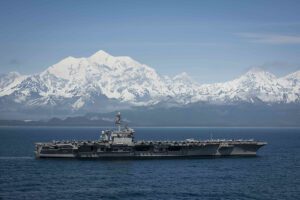
Thousands of U.S. military service members, five ships and over 150 aircraft are in Alaska for Northern Edge 2023 (NE23), war games in the Gulf of Alaska and elsewhere in the state to enhance combat readiness.
They are being joined for the Indo-Pacific Command exercise by other service members from the United Kingdom and Australia to provide opportunity for joint, multinational and multi-domain operations designed to offer high-end, realistic war fighter training. Commanding officers describe NE23 as an example of their strong relationship with the state of Alaska and one that demonstrates the U.S. commitment to the region by building interoperability, and a commitment to U.S. allies and partners in ensuring a free and open Indo-Pacific region.
Northern Edge got under way on May 4. For security reasons, the start of the biennial training is never announced until it’s already underway.
While military officials say it is necessary to have the war game, this year in a broadly expanded area, fishermen and environmentalists have voiced concern that such live-fire training drills may have adverse impacts on sea mammals, including whales, and scare off wild salmon headed through the Gulf of Alaska to Prince William Sound and the famed Copper River fishery.
Military officials said again this year that these exercises, particularly in the Gulf of Alaska, are not affecting the fish. They point to the Navy’s marine species monitoring program in the Gulf of Alaska, which they say is dedicated to protecting marine and coastal environment.
The Navy has funded marine species monitoring in the Gulf since 2009. More information on the monitoring program is online at www.navymarinespeciesmonitoring.us.
Navy spokesperson John Mosher noted that while this year’s training area is substantially increased to allow for maneuverability of military equipment that no explosives or sonar will be used in the new area in international waters.
Environmental entities are skeptical of the timing of NE23.
Carol Hoover, executive director of the Eyak Preservation Council in Cordova, said these military exercises are taking place when all Gulf of Alaska wildlife are returning, when the weather is better and there’s more light.
“And most predominately, as it was stated in the record of decision, the Navy has no existing procedural protective measures in place specifically for fish, Hoover said.
“These trainings, with explosives and sonar, are happening during the first large wild salmon run in the Alaska, the Copper River wild salmon run. And no non-military observers are allowed,” she said.
“The intense environmental studies notwithstanding, they have ignored pleas for communities encircling the entire region, to not hold NE23 in May,” she stated.
